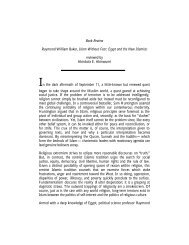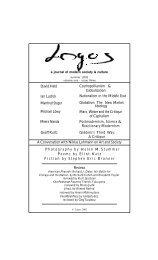Michael J. Thompson Stephen Eric Bronner Wadood Hamad - Logos
Michael J. Thompson Stephen Eric Bronner Wadood Hamad - Logos
Michael J. Thompson Stephen Eric Bronner Wadood Hamad - Logos
You also want an ePaper? Increase the reach of your titles
YUMPU automatically turns print PDFs into web optimized ePapers that Google loves.
Ali Hossaini<br />
The urban state has unfolded from the concept of the sky god, idealized as a<br />
tyrant who governs the earthly state through all-encompassing vision. Aerial<br />
perspective—conceived as a divine seat, but realized as the technology of<br />
surveying—was a key advance in the feasibility of state institutions.<br />
Surveying realizes the perspective of the Inanna and her ilk, and architecture<br />
embodies their creative will, which depended on their ability to view land<br />
from an objective vantage. From its first appearance in land surveying, the<br />
organization of vision has driven the development of optics, and the drive to<br />
merge individual and collective perception continues. Architecture and media<br />
both derive from the objective gaze, and the modern spy satellite, surveying<br />
the masses below, is its virtual embodiment. In non-political terms, we could<br />
say that photography arose from a concern with method. What is the proper<br />
way to represent the environment? Whether manifest in Sumerian surveying,<br />
Renaissance painting or aerial surveillance, this question bears on the<br />
aesthetic, political and scientific concerns surrounding perceptual<br />
technologies. Though technical in nature, it is wrapped in the institutions of<br />
power—property and architecture—that caused it to emerge.<br />
How do we define property as a practical concept? Sumerian religion<br />
provided the first transactive language, or code, for comprehending land in<br />
terms of legal ownership. Pre-urban societies assign landholdings according to<br />
organic need, and the size of plots are naturally limited by the ability of<br />
owners to manage an area. Sky gods owned the land beneath their gaze, and<br />
they conveyed ownership to select classes within society as a legal right. By<br />
underpinning the legal doctrine of ownership, the sky god constituted the<br />
state and simultaneously posed a perceptual problem to its adherents.<br />
Ownership demanded management, but Mesopotamian leaders could only<br />
comprehend small areas with their native faculties—an area big enough to<br />
feed themselves and their families. In order to govern larger areas, they<br />
needed to attain the perspective of the sky god. Land surveying solved their<br />
problem. By combining simple surveying techniques with advances in<br />
accounting, early managers could remotely manage their estates, an ability<br />
which greatly extended their capacity to rule. The priests of Mesopotamia<br />
used geometry to attain the vision of gods.<br />
In contemporary terms, we might call this action at a distance telepresence or<br />
virtual experience. The key to understanding why these terms apply lies in<br />
our definition of reality. If “real” means a visually correct image of a distant<br />
place, then they are certainly inappropriate. But if “real” describes an accurate<br />
<strong>Logos</strong> 2.3 – Summer 2003




